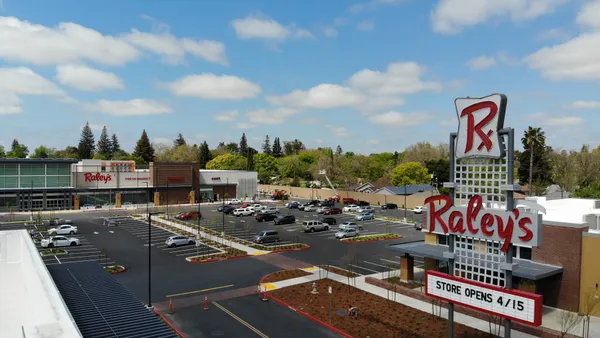Dive Brief:
- Walmart will consolidate its digital and in-store buying teams into one merchandising organization, according to a memo emailed to sister publication Retail Dive and first reported by The Wall Street Journal.
- The move follows several management shifts as the company adopts an omnichannel operational strategy. In July, Walmart united all supply chain functions under one leader (Executive Vice President of Supply Chain Greg Smith) aiming to create "one, seamless Walmart experience." Smith reports jointly to CEO of Walmart U.S. John Furner and CEO of Walmart e-commerce Marc Lore. Walmart's memo said the consolidation of the buying and merchandising functions are a continuation of that work.
- The consolidation will happen gradually, according to the memo, starting with food and other consumables. The single merchandising team will be divided into apparel, consumables, entertainment, food, hardlines and home. The company has appointed Chandra Holt, formerly COO of Sam's Club, to lead the integration of Walmart e-commerce into the unified buying team as chief merchandising and integration officer for Walmart e-commerce, reporting to recently installed Chief Merchandising Officer Scott McCall.
Dive Insight:
Walmart's memo emphasized the move to unite buying across delivery channels is to better serve the customer — adding product, assortment and pricing to the list of points where stores and digital must coordinate. Bringing together buying operations should simplify communications with vendors and offer new efficiencies. On the consumer side, it should make Walmart's website a better representation of what's in store.
Walmart revealed at an investor presentation last week it will soon bring together its grocery and general merchandise apps — providing more incentive for the back-office organization to mirror the customer's view of Walmart.
Starting the transition to unified buying with food and consumables emphasizes the importance of this category to Walmart's omnichannel success thus far. Online grocery sales, pickup and delivery, are a major contributor to Walmart's total grocery sales and e-commerce growth.
Moody's lead retail analyst, Charlie O'Shea, told Supply Chain Dive the consolidation is a logical progression for Walmart as it unites digital and physical retail. Walmart.com launched in 2000 with a headquarters in the San Francisco Bay area, 1,800 miles from Bentonville, Arkansas.
"When setting up online, retailers were essentially starting second businesses, and overlap was a natural result," said O'Shea.
Target underwent a similar unification effort on the buying side in 2018, according to a former executive of Walmart and Target, who described there was no formal mechanism at Walmart for the digital and store buying teams to coordinate as recently as 2016.
Retail consultant Toopan Bagchi, senior advisor at The Navio Group, told Supply Chain Dive the outgoing structure is likely a remnant of the early days of digital. He echoed Walmart's sentiment that a seamless experience for the customer can't come out of an organization with siloed digital and physical retail operations.
"Separate organizations were appropriate in the early days of e-commerce when it was viewed as a distraction and frankly needed to be separate and given resources and space to grow," said Bagchi. "It’s also led to unnecessary duplication across a number of functions as the teams have grown over the last 10-20 years."
A Walmart spokesperson told Supply Chain Dive reducing headcount is not the intent of the move and that the retailer will not physically bring together the merchandising teams in Bentonville, Arkansas.














